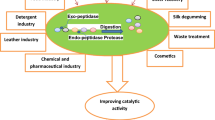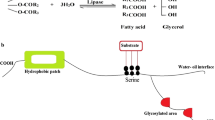Abstract
The main goals of this work were to produce the fusion protein of the Trichoderma reesei swollenin I (SWOI) and Aspergillus niger feruloyl esterase A (FAEA) and to study the effect of the physical association of the fusion partners on the efficiency of the enzyme. The fusion protein was produced up to 25 mg l−1 in the T. reesei strains Rut-C30 and CL847. In parallel, FAEA alone was produced for use as a control protein in application tests. Recombinant FAEA and SWOI–FAEA were purified to homogeneity and characterized. The biochemical and kinetic characteristics of the two recombinant proteins were found to be similar to those of native FAEA, except for the temperature stability and specific activity of the SWOI–FAEA. Finally, the SWOI–FAEA protein was tested for release of ferulic acid from wheat bran. A period of 24 h of enzymatic hydrolysis with the SWOI–FAEA improved the efficiency of ferulic acid release by 50% compared with the results obtained using the free FAEA and SWOI. Ferulic acid is used as an antioxidant and flavor precursor in the food and pharmaceutical industries. This is the first report of a potential application of the SWOI protein fused with an enzyme of industrial interest.





Similar content being viewed by others
References
Boraston AB, Bolam DN, Gilbert HJ, Davies GJ (2004) Carbohydrate-binding modules: fine-tuning polysaccharide recognition. Biochem J 382:769–781
Ciruela AHJ, Gilbert BR Ali, Hazlewood GP (1998) Synergistic interaction of the cellulosome integrating protein (CipA) from Clostridium thermocellum with a cellulosomal endoglucanase. FEBS Lett 422:221–224
Cosgrove DJ (2000a) Expansive growth of plant cell walls. Plant Physiol Biochem 38:109–124
Cosgrove DJ (2000b) Loosening of plant cell wall by expansin. Nature 407:321–326
Crepin VF, Faulds CB, Connerton IF (2003) Functional classification of the microbial feruloyl esterases. Appl Microbiol Biotechnol 63:647–652
Din N, Gilkes NR, Tekan B, Miller RC Jr, Warren RAJ, Kilburn DG (1991) Non-hydrolytic disruption of cellulose fibers by the binding domain of a bacterial cellulose. Bio/Technology 9:1096–1099
Durand H, Baron M, Calmels T, Tiraby G (1988) Classical and molecular genetics applied to Trichoderma reesei for the selection of improved cellulolytic industrial strains. FEMS Symp 43:135–152
Faulds CB, Williamson G (1994) Purification and characterization of a ferulic acid esterase (FAEIII) from Aspergillus niger: specificity for the phenolic moiety and binding to microcrystalline cellulose. Microbiology 140:779–787
Fierobe HP, Bayer EA, Tardif C, Czjzek M, Mechaly A, Belaich A, Lamed R, Shoham Y, Belaïch J-P (2002) Degradation of cellulose substrates by cellulosome chimeras. Substrate targeting versus proximity of enzyme components. J Biol Chem 277:49621–49630
Gao PJ, Chen GJ, Wang TH, Zhang YS, Liu J (2001) Non-hydrolytic disruption of crystalline structure of cellulose by cellulose binding domain and linker sequence of cellobiohydrolase I from Penicillium janthinellum. Sheng Wu Hua Xue Yu Sheng Wu Wu Li Xue Bao (Shaghai) 33:13–18
Ho SN, Hunt HD, Horton RM, Pullen JK, Pease LR (1989) Site-directed mutagenesis by overlap extension using the polymerase chain reaction. Gene 77:51–59
Ito J, Fujita Y, Ueda M, Fukuda H, Kondo A (2004) Improvement of cellulose-degrading ability of a yeast strain displaying Trichoderma reesei endoglucanase II by recombination of cellulose-binding domains. Biotechnol Prog 20:688–691
Juge N, Wiliamson G, Puigserver A, Cummings NJ, Connerton IF, Faulds CB (2001) High-level production of recombinant Aspergillus niger cinnamoyl esterase (FAEA) in the methylotrophic yeast Pichia pastoris. FEMS Yeast Res 1:127–132
Kroon PA, Faulds CB, Williamson G (1996) Purification and characterization of a novel esterase induced by growth of Aspergillus niger on sugar beet pulp. Biotechnol Appl Biochem 23:255–262
Laemli UK (1970) Cleavage of structural proteins during the assembly of the head of bacteriophage T4. Nature 227:680–685
Levasseur A, Benoit I, Asther M, Asther M, Record E (2004a) Homologous expression of the feruloyl esterase B gene from Aspergillus niger and characterization of the recombinant enzyme. Protein Expr Purif 37:126–133
Levasseur A, Pagès S, Fierobe HP, Navarro D, Punt P, Belaïch J-P, Asther M, Record E (2004b) Design and production in Aspergillus niger of a chimeric protein associating a fungal feruloyl esterase and a clostridial dockerin domain. Appl Environ Microbiol 70:6984–6991
Levasseur A, Navarro D, Punt PJ, Belaïch J-P, Asther M, Record E (2005) Improvement of ferulic acid release by action of engineered bifunctional enzymes associating the feruloyl esterase A, the xylanase B and a carbohydrate-binding module from Aspergillus niger. Appl Environ Microbiol 71:8132–8140
Li Y, Jones L, McQueen-Mason (2003) Expansins and cell growth. Curr Opin Plant Biol 6:603–610
Limon MC, Chacon MR, Mejias R, Delgado-Jarana J, Rincon AM, Codon AC, Benitez T (2004) Increased antifungal and chitinase specific activities of Trichoderma harzianum CECT 2413 by addition of a cellulose binding domain. Appl Microbiol Biotechnol 64:675–685
Lowry OH, Rosebrough NJ, Farr AL, Randall RJ (1951) Protein measurement with the Folin phenol reagent. J Biol Chem 193:265–275
Montenecourt BS, Eveleigh DE (1977) Selective screening methods for the isolation of high yielding cellulase mutants of Trichoderma reesei on various carbon sources. Adv Chem Ser 181:289–301
Pagès S, Belaïch A, Belaïch J-P, Morag E, Lamed R, Shoham Y, Bayer EA (1997) Species-specificity of the cohesin-dockerin interaction between Clostridium thermucellum and Clostridium cellulolyticum: prediction of specificity determinants of the dockerin domain. Proteins: Structure, Function and Genetics 29:517–527
Penttila M, Nevalainen H, Ratto M, Salminen E, Knowles J (1987) A versatile transformation system for the cellulolytic filamentous fungus Trichoderma reesei. Gene 61:155–164
Porath J, Carlsson J, Olsson I, Belfrage G (1975) Metal chelate affinity chromatography, a new approach to protein fractionation. Nature 258:598–599
Record E, Asther M, Sigoillot C, Pagès S, Punt PJ, Delattre M, Haon M, van den Hondel CA, Sigoillot J-C, Lesage-Meessen L, Asther M (2003) Overproduction of the Aspergillus niger feruloyl esterase for pulp bleaching application. Appl Microbiol Biotechnol 62:349–355
Ralet MC, Faulds CB, Williamson G, Thibault JF (1994) Degradation of feruloylated oligosaccharides from sugar-beet pulp and wheat bran by ferulic acid esterases from Aspergillus niger. Carbohydr Res 263:257–269
Reese ET, Siu RGH, Levinson HS (1950) The biological degradation of soluble cellulose derivatives and its relationship to the mechanism of cellulose hydrolysis. J Bacteriol 59:485–497
Saloheimo M, Paloheimo M, Hakola S, Pere J, Swanson B, Nyyssonen E, Bhatia A, Ward M, Penttila M (2002) Swollenin, a Trichoderma reesei protein with sequence similarity to the plant expansins, exhibits disruption activity on cellulosic materials. Eur J Biochem 269:4202–4211
Saulnier L, Thibault JF (1999) Ferulic acid and diferulic acids as components of sugar-beet pectins and maize bran heteroxylans. J Sci Food Agric 79:396–402
Sigoillot C, Camarero S, Vidal T, Record E, Asther M, Perez-Boada M, Martinez MJ, Sigoillot JC, Asther M, Colom JF, Martinez AT (2005) Comparison of different fungal enzymes for bleaching high-quality paper pulps. J Biotechnol 115:333–343
Williamson G, Kroon PA, Faulds GB (1998) Hairy plant polysaccharides: a close shave with microbial esterases. Microbiology 144:2011–2023
Acknowledgements
This research was supported by the sixth European Framework Program for Research and Technological Development (FP6), Integrated Project No. 019882; NILE project: New Improvements for Lignocellulosic Ethanol; and the French Programme National de Recherche sur les Bioénergies (PNRB), SPECABBE project, Stratégie de Prétraitements Physiques, Enzymatiques, et Chimiques Appliquées à la Biomasse–Bio-Ethanol.
Author information
Authors and Affiliations
Corresponding author
Rights and permissions
About this article
Cite this article
Levasseur, A., Saloheimo, M., Navarro, D. et al. Production of a chimeric enzyme tool associating the Trichoderma reesei swollenin with the Aspergillus niger feruloyl esterase A for release of ferulic acid. Appl Microbiol Biotechnol 73, 872–880 (2006). https://doi.org/10.1007/s00253-006-0546-8
Received:
Revised:
Accepted:
Published:
Issue Date:
DOI: https://doi.org/10.1007/s00253-006-0546-8




